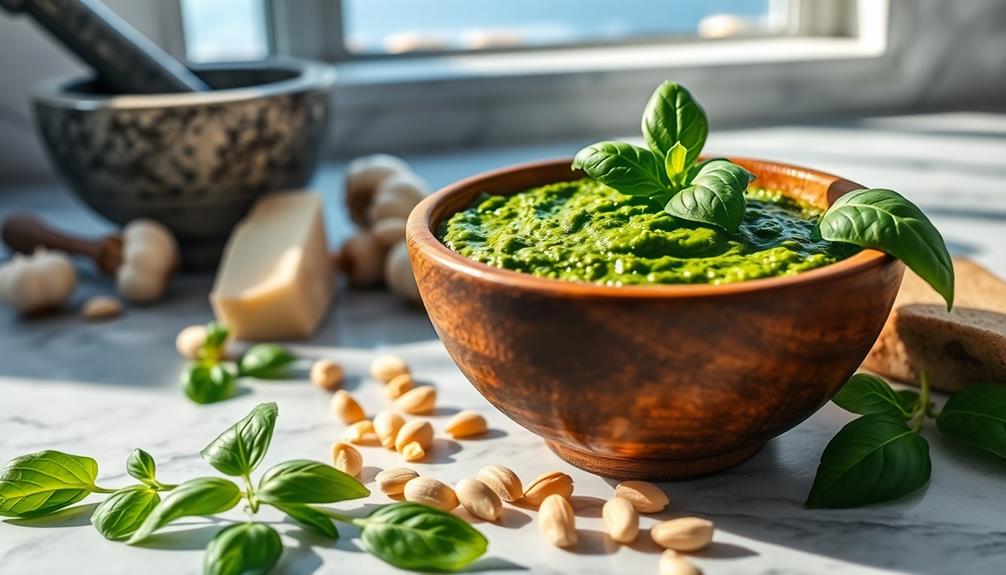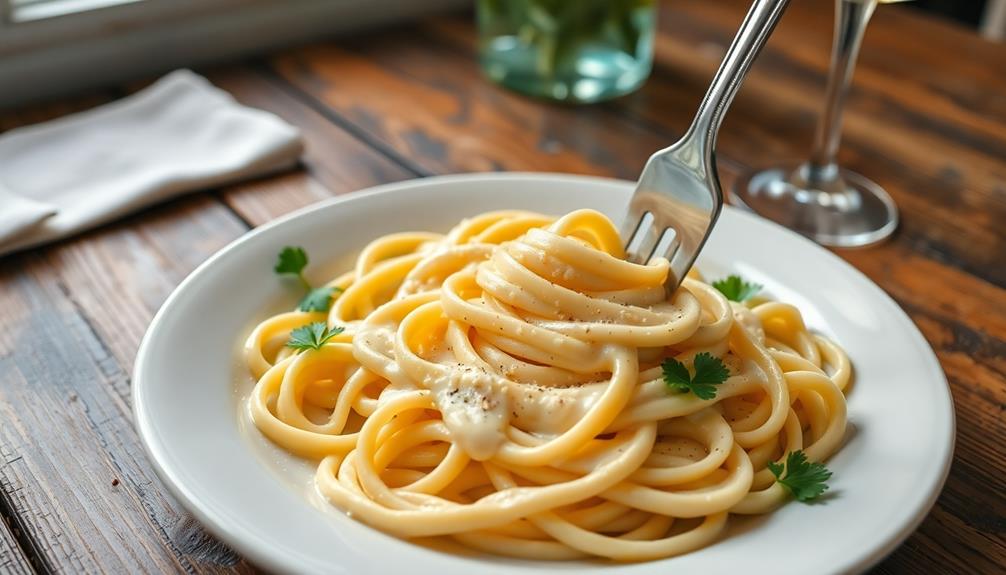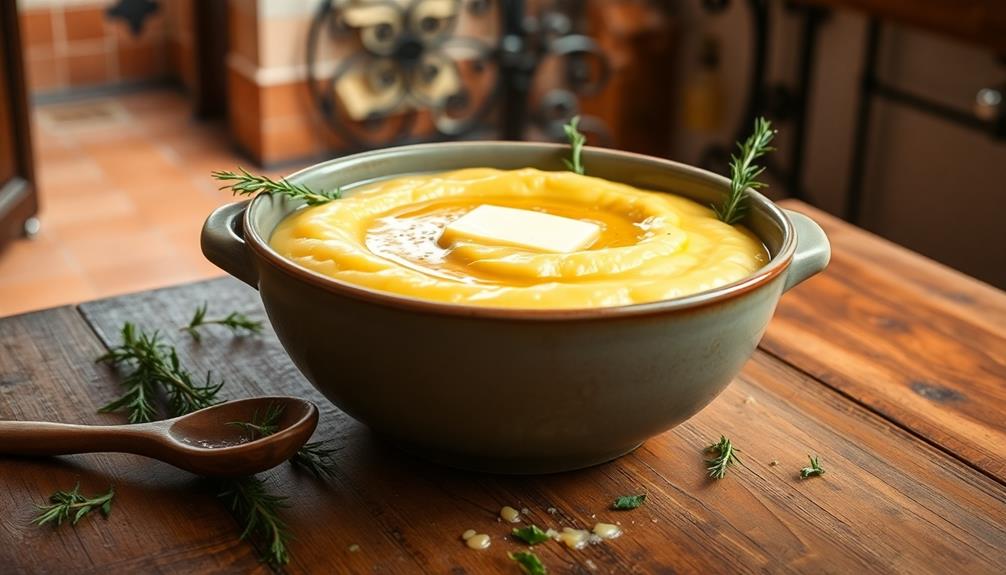You'll love Pesto alla Genovese, a delicious Italian sauce from Liguria! It's made with fresh basil, olive oil, garlic, cheese, and pine nuts. This bright green sauce has been around for centuries and was even used by sailors to prevent scurvy. Today, it's popular all over the world. You can make it easily at home using a food processor or the traditional mortar and pestle. It's perfect for pasta, sandwiches, or as a dip. Kids and adults alike enjoy its fresh, zesty flavor. Store it in the fridge or freeze it for later use. There's so much more to discover about this tasty sauce!
Key Takeaways
- Pesto Alla Genovese originated in Genoa, Italy, and is traditionally made with fresh basil, olive oil, garlic, Parmigiano-Reggiano cheese, and pine nuts.
- The classic preparation method uses a mortar and pestle, though modern versions often employ food processors for convenience.
- Key ingredients include fresh basil leaves, extra-virgin olive oil, garlic, Parmigiano-Reggiano cheese, and pine nuts (or walnuts as a substitute).
- Pesto is versatile and can be used with pasta, as a spread, dip, or sauce for various dishes.
- For best results, store pesto in an airtight container with a layer of olive oil on top and use within a week or freeze for longer storage.
History
Long ago, people in Genoa started making pesto using a mortar and pestle. They'd crush fresh basil leaves, garlic, pine nuts, and cheese together to create a flavorful paste. It was a great way to preserve basil's taste and aroma.
Here are some fun facts about pesto's history:
- In the 19th century, pesto recipes first appeared in cookbooks
- Sailors used to take pesto on long voyages to prevent scurvy
- The sauce became popular across Italy after World War II
Today, you can find pesto in homes and restaurants all over the world. It's not just for pasta anymore!
People love using it on:
- Sandwiches
- Pizza
- Soups
- Salad dressings
You're part of a long, tasty tradition when you enjoy pesto. It's a delicious way to connect with Italian culinary history!
Recipe
Pesto alla Genovese is a classic Italian sauce originating from the Liguria region, specifically the city of Genoa. This vibrant green sauce is known for its fresh, aromatic flavor and versatility in various dishes. Traditionally made with a mortar and pestle, modern versions often utilize a food processor for convenience. It is made from a blend of fresh basil, pine nuts, garlic, Parmigiano-Reggiano cheese, and olive oil. Pesto alla Genovese is a staple in Italian cuisine and is commonly used as a sauce for pasta, a spread on sandwiches, or a topping for grilled meats and seafood. One classic dish that showcases the versatility of this sauce is the vitello tonnato recipe, where thinly sliced veal is served with a creamy tuna and caper sauce, and topped with a generous dollop of pesto alla Genovese.
The key to an authentic Pesto alla Genovese lies in using high-quality, fresh ingredients. The combination of fragrant basil, rich extra-virgin olive oil, pungent garlic, and nutty Parmigiano-Reggiano creates a harmonious blend of flavors that has made this sauce a favorite worldwide. While pine nuts are traditional, some variations use walnuts or even omit nuts altogether.
- 2 cups fresh basil leaves, packed
- 1/2 cup freshly grated Parmigiano-Reggiano cheese
- 1/4 cup freshly grated Pecorino Romano cheese
- 1/3 cup pine nuts
- 2 cloves garlic, peeled
- 1/2 cup extra-virgin olive oil
- Salt to taste
To prepare Pesto alla Genovese, begin by lightly toasting the pine nuts in a dry pan until golden. Allow them to cool. In a food processor, combine the basil, cooled pine nuts, garlic, and both cheeses. Pulse the mixture until coarsely chopped.
With the processor running, slowly drizzle in the olive oil until the desired consistency is reached. Season with salt to taste. If not using immediately, transfer the pesto to an airtight container and cover the surface with a thin layer of olive oil to prevent oxidation.
For the best flavor, use the pesto immediately or within a day or two. If storing, keep it refrigerated for up to a week. To prevent discoloration, blanch the basil leaves briefly in boiling water, then shock in ice water before using. This will help maintain the vibrant green color.
When tossing with pasta, reserve some of the pasta cooking water to help the sauce coat the noodles evenly. Remember, a little pesto goes a long way – start with a small amount and add more as needed to suit your taste.
Cooking Steps
Get ready to make some delicious pesto!
You'll start by gathering fresh basil leaves and toasting pine nuts to bring out their flavor.
Next, you'll grate Parmigiano-Reggiano cheese, crush garlic with a mortar, and blend all the ingredients until they're smooth and creamy.
Step 1. Gather Fresh Basil Leaves
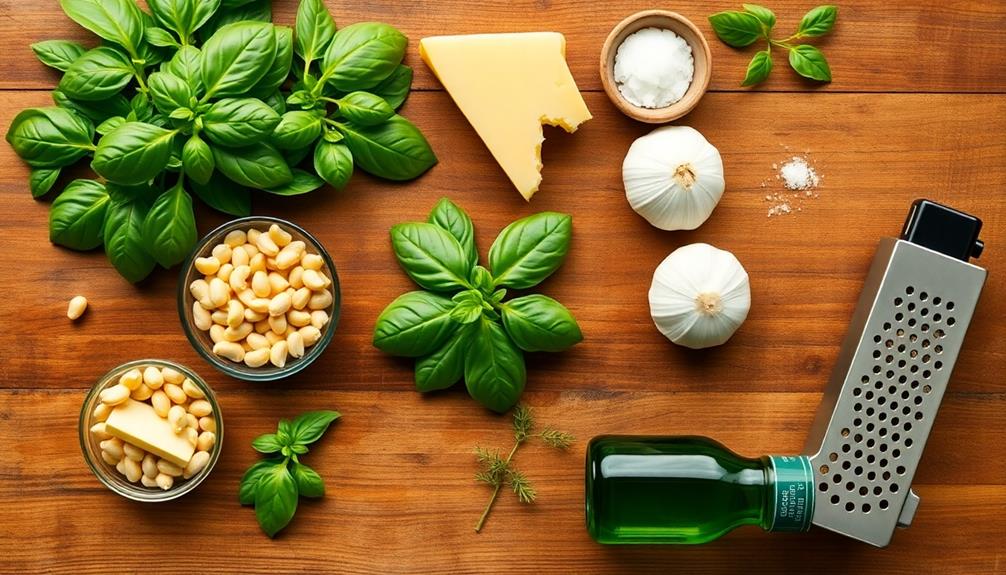
While preparing authentic Pesto Alla Genovese, the first crucial step is gathering fresh basil leaves. You'll want to head out to your garden or local market to find the best basil you can. Look for bright green leaves that smell amazing when you rub them gently. Make sure they're free from any brown spots or wilting.
Here's what to keep in mind when gathering your basil:
- Choose young, tender leaves for the best flavor
- Avoid flowers or buds, as they can make the pesto bitter
- Pick leaves in the morning when they're most flavorful
- Gather about 2 cups of packed leaves for a standard recipe
Once you've got your basil, give it a gentle wash in cool water. Pat the leaves dry with a clean kitchen towel or use a salad spinner. Don't bruise them!
Now you're ready for the next exciting step in creating your delicious Pesto Alla Genovese. Remember, fresh basil is the star of this dish, so take your time to select the very best leaves you can find. Your taste buds will thank you!
Step 2. Toast Pine Nuts
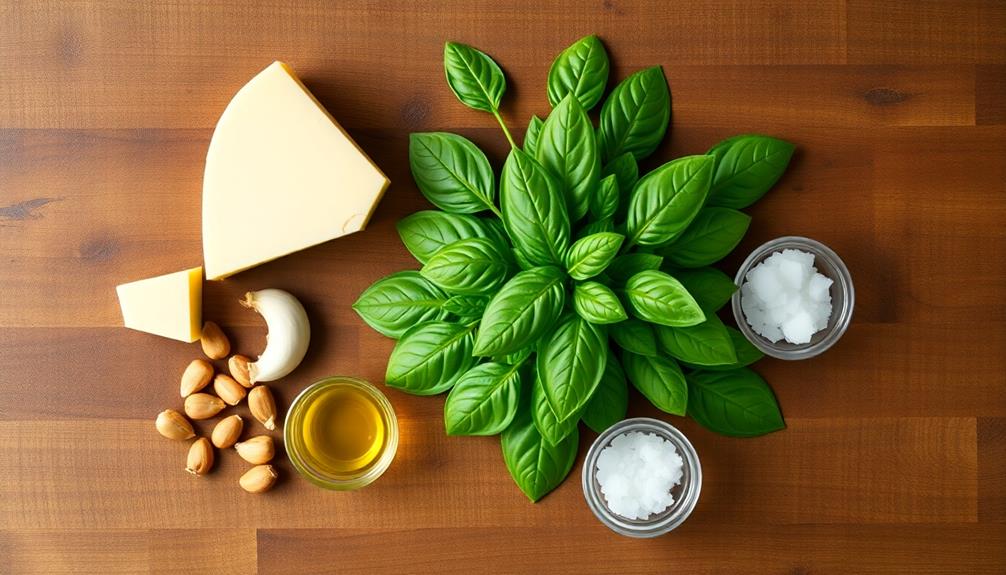
The next crucial step in preparing your Pesto Alla Genovese is toasting the pine nuts. This simple process brings out their nutty flavor and adds a delightful crunch to your pesto. Here's how to do it:
- Grab a small, dry skillet
- Place it on the stove over medium heat
- Add your pine nuts to the pan
Watch closely as the pine nuts start to turn golden brown. They'll smell amazing! Keep them moving in the pan by gently shaking it or stirring with a wooden spoon. This helps them toast evenly and prevents burning.
Be careful, though! Pine nuts can go from perfectly toasted to burnt in a flash. It'll only take about 3-5 minutes for them to reach that beautiful golden color.
When they're done, immediately transfer them to a plate to cool.
Once they're cool enough to touch, give them a taste. You'll love the rich, toasty flavor! It's like a little preview of how yummy your pesto's going to be.
Now you're ready for the next exciting step in your Pesto Alla Genovese adventure!
Step 3. Grate Parmigiano-Reggiano Cheese

With your pine nuts toasted to perfection, it's time to focus on another key ingredient: Parmigiano-Reggiano cheese. This hard, aged cheese is a must-have for authentic pesto alla Genovese. Let's get grating!
Here's what you'll need:
- A block of Parmigiano-Reggiano cheese
- A cheese grater
- A clean bowl
Follow these steps:
- Unwrap your cheese and give it a quick rinse.
- Hold the grater at an angle over your bowl.
- Firmly run the cheese down the grater's surface.
- Keep grating until you have about 1/2 cup of cheese.
Tips for success:
- Use the small holes on your grater for a fine texture.
- Grate in short, quick motions for best results.
- If the cheese gets sticky, pop it in the freezer for 5 minutes.
Step 4. Crush Garlic With Mortar

Now that your cheese is grated, it's time to tackle the garlic. Grab your mortar and pestle, the dynamic duo of crushing herbs and spices. You'll need:
- 2-3 cloves of fresh garlic
- A pinch of coarse salt
First, peel the garlic cloves and drop them into the mortar. Add a pinch of salt – it'll help break down the garlic and enhance its flavor.
Now, let's get crushing!
Hold the pestle firmly and start grinding the garlic against the sides of the mortar. Use a circular motion, pressing down as you go. You'll notice the garlic starting to break apart and release its aroma. Keep at it until you've got a smooth paste.
As you crush, you might find yourself getting excited about the delicious pesto you're creating. That's normal! The smell of fresh garlic is enough to make anyone's mouth water.
Once your garlic is crushed to a paste, you're ready for the next step. But don't wash that mortar yet – you'll need it for the basil leaves coming up next!
Step 5. Blend Ingredients Until Smooth

Finally, it's time to bring all your ingredients together. You're so close to enjoying your homemade pesto! Here's what you'll do next:
- Add the crushed garlic and basil leaves to your food processor or blender.
- Toss in the pine nuts and grated cheese.
- Pour in the olive oil.
- Sprinkle a pinch of salt to taste.
Now, get ready for the fun part! Turn on your food processor and watch the magic happen.
You'll see all the ingredients swirling together, creating a beautiful green paste. Keep blending until everything looks smooth and creamy. If it's too thick, don't worry! Just add a little more olive oil to help it blend better.
Final Thoughts
Pesto alla Genovese stands out as a classic Italian sauce that's both versatile and flavorful.
You've now mastered the art of making this delightful green sauce, and it's time to enjoy the fruits of your labor! Here are some fun ways to use your homemade pesto:
- Toss it with pasta for a quick and tasty meal
- Spread it on sandwiches or wraps
- Use it as a dip for fresh veggies or bread
- Drizzle it over grilled chicken or fish
Remember, pesto is best enjoyed fresh, but you can store it in the fridge for up to a week.
If you've made extra, freeze it in ice cube trays for easy portioning later. Just pop out a cube whenever you need a burst of flavor!
Additionally, while enjoying your culinary creation, be mindful of what ingredients are safe for your pets; for instance, dogs and grapes can be a dangerous combination, as grapes are toxic to dogs.
As you savor your pesto, think about the rich history behind this Ligurian specialty.
It's amazing how a few simple ingredients can come together to create something so delicious.
Whether you're sharing it with family or friends, your homemade pesto is sure to be a hit at any gathering. Enjoy your culinary creation!
Frequently Asked Questions
Can Pesto Be Frozen for Later Use?
Yes, you can freeze pesto for later use. It's a great way to preserve your homemade sauce. Simply store it in an airtight container or ice cube tray, leaving some space for expansion. It'll keep for up to 6 months.
What's the Best Type of Pasta to Serve With Pesto?
You'll find that short pasta shapes work best with pesto. Try using fusilli, rotini, or farfalle. Their twists and crevices hold the sauce well. Linguine and spaghetti are also popular choices. Avoid long, flat noodles like fettuccine.
How Long Does Homemade Pesto Last in the Refrigerator?
You'll find that homemade pesto typically lasts 5-7 days in the refrigerator. To extend its shelf life, you can add a thin layer of olive oil on top. Always store it in an airtight container for best results.
Are There Any Common Allergens in Traditional Pesto?
You'll need to watch out for common allergens in traditional pesto. It often contains pine nuts and Parmesan cheese, which can trigger nut and dairy allergies. Basil might also cause reactions in some people.
Can Pesto Be Used as a Marinade for Meats?
You can definitely use pesto as a marinade for meats. It's versatile and flavorful, adding a delicious herb and garlic taste. Simply coat your meat with pesto and let it marinate for a few hours before cooking.
